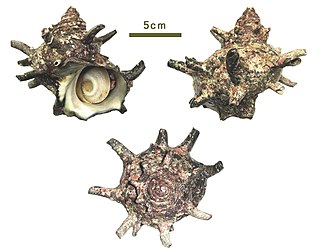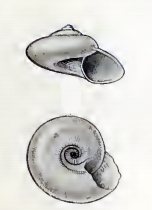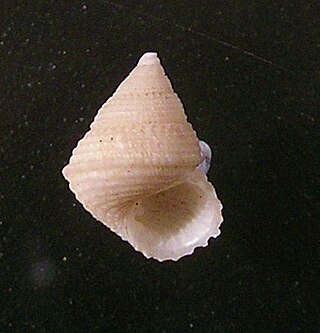
Turbinidae, the turban snails, are a family of small to large marine gastropod molluscs in the superfamily Trochoidea.

The Buccinidae are a very large and diverse taxonomic family of large sea snails, often known as whelks or true whelks.

Neritidae, common name the nerites, is a taxonomic family of small to medium-sized saltwater and freshwater snails which have a gill and a distinctive operculum. The family Neritidae includes marine genera such as Nerita, marine and freshwater genera such as Neritina, and freshwater and brackish water genera such as Theodoxus.

Trimusculus is a genus of medium-sized air-breathing sea snails or false limpets, marine pulmonate gastropod molluscs in the family Trimusculidae.

The Nassariidae, Nassa mud snails (USA), or dog whelks (UK), are a taxonomic family of small to medium-sized sea snails, marine gastropod mollusks in the clade Neogastropoda.

Caecidae is a taxonomic family of very small and minute sea snails or micromolluscs, marine gastropod molluscs in the order Littorinimorpha.
Mathildidae is a family of minute sea snails, marine gastropod molluscs in the superfamily Mathildoidea of the informal group of the Lower Heterobranchia.

Tornidae is a family of very small and minute sea snails with an operculum, marine gastropod mollusks in the clade Littorinimorpha. This family used to be known as the Vitrinellidae. Iredale has shown that the family Adeorbidae Monterosato, 1884 should be called Tornidae

Solariellidae is a family of small sea snails, marine gastropod mollusks in the superfamily Trochoidea.

Liotiidae is a family of small sea snails, marine gastropod mollusks in the clade Vetigastropoda.

Cylichnidae, common name the "chalice bubble snails" or "canoe bubble snails" is a family of sea snails or bubble snails, marine gastropod mollusks in the superfamily Cylichnoidea.

Microvoluta is a genus of very small sea snails, marine gastropod molluscs in the family Volutomitridae.

Micrelenchus is a genus of small sea snails that have shells with pearly interiors and an operculum. They are marine gastropod molluscs in the subfamily Cantharidinae of the family Trochidae, the top snails or top shells.

Seguenzioidea is a superfamily of minute to medium-sized sea snails, marine gastropod mollusks in the clade Vetigastropoda.

Iravadiidae is a family of minute sea snails, marine gastropod molluscs in the superfamily Truncatelloidea and the clade Littorinimorpha.

Colloniidae is a family of small sea snails with calcareous opercula, marine gastropod mollusks in the clade Vetigastropoda.

Capulus is a genus of small sea snails, marine gastropod mollusks in the family Capulidae, the cap snails.

The subfamily Emarginulinae, common name keyhole limpets and slit limpets, is a taxonomic subfamily of limpet-like sea snails, marine gastropod molluscs in the family Fissurellidae, the keyhole limpets and slit limpets.

The Cantharidinae are a taxonomic subfamily of very small to large sea snails, marine gastropod molluscs in the family Trochidae, common name top snails.

Echinophoria is a genus of large sea snails, marine gastropod mollusks in the family Cassidae, the helmet snails and bonnet snails.



















